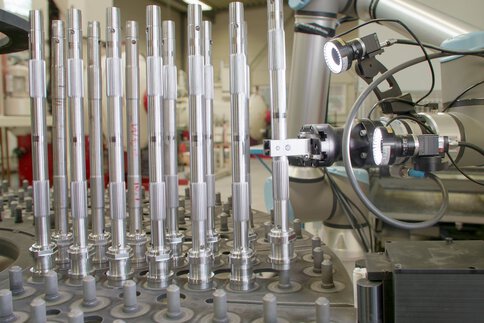automatica 2025: hands-on AI solution experience
Billion-dollar-investments, supercomputers, and the struggle for a new world order – artificial intelligence remains an exciting and visionary topic. And on the application level, tried-and-tested AI solutions have been demonstrating for a while now that advantages in production can be achieved with manageable investments. Numerous exhibitors at automatica will show how.
This topic is just too fascinating to not take a brief glimpse into the future—a future where humans and AI might merge almost entirely. The start-up Neuralink and its N1 chip shows just how close such scenarios already are. A surgical robot can implant the chip into the skull of patients such as paraplegics.
64 extremely thin wires lead from the implant directly into the brain. They are connected to electrodes transmitting signals to a software, which is trained to recognize specific thought patterns. The patient can trigger these signals and, thus, operate a computer or other devices. Several people already have such N1 chip implants, and they help them regain some quality of life. Further, it is at least conceivable to provide paralyzed persons with a prosthetic device they can control with their thoughts via the chip.
Workable AI in industrial automation
The production process improvements enabled by AI-based robotics may not be quite as spectacular, but they certainly are impressive. Numerous suppliers will showcase their latest AI application components at automatica – including 2D/3D cameras, vibration sensors, proximity sensors, accelerometers, gripping systems, controllers, high-performance computers, robots, cobots, AGVs, and AMRs. The ease of turning a standard robot application into a pioneering AI solution is astonishing.
Example HWL Löttechnik: The company has automated metal rod loading and unloading into and from washing baskets using AI and cobots—even though the process requires decidedly human skills: The metal rods vary in size and weight, and they are randomly arranged in the basket as they are removed. They also cause reflections, which prevents many image processing systems from operating properly. But Mirai, the AI-based vision system from Micropsi Industries, is different. It is meets all requirements perfectly and enables a Universal Robots cobot to take on the task. Neither variations in the positioning and appearance of the metal rods nor changing lighting conditions along with the resulting workpiece surface reflections have any adverse effect on the solution’s process reliability. The AI solution has enabled HWL Löttechnik to optimize cycle times by 20 percent, reduce costs, and ease the burden on employees.


Fully automated unloading without time-consuming teaching
Another example shows how AI can be leveraged to take a conventional robot application to a whole new level. It is about automated unloading of processing machinery—an application Hans Weber Maschinenfabrik now offers an AI standard cell for. This cell has made time-consuming programming a thing of the past. The robot will also pick up any parts that have not been taught, and then place them on a europallet. Just like that—with no human intervention or any prior teaching.
“Genuinely automated unloading of processing machinery is a great application example as it makes maximum use of the benefits that systems based on artificial intelligent have to offer. No teaching, no complex programming effort – AI unlocks the advantages of robot automation for a wide range of users without existing programming skills,” says Peter Pühringer, Managing Director of Stäubli Robotics in Bayreuth.
At first glance, you can't tell the level of ingenuity inherent in the AI unloading system: a large Stäubli TS2-100 Scara with automatic tool changing system, a high-end optical recognition system with AI software by Mech-Mind Robotics, and a robust conveyor system—that makes one compact masterpiece. Users will find every conceivable component for implementing such (and many other) applications at automatica.
New approach to AI-powered cobots
The trade fair will also show how cobots are evolving in terms of AI adoption. In this context, the integration of AI-based software with collaborative robots represents a turning point in smart automation. Cobots aided by AI will be able to work alongside humans even more closely and efficiently in the future.
Universal Robots recently presented its latest hardware and software toolkit for such applications: “Our UR AI Accelerator offers our partners everything they need to develop and deploy new, innovative AI solutions,” says Kim Povlsen, CEO and President of Universal Robots. Developers can use it to upgrade their robotics solutions with state-of-the-art AI technology—it’s easy, quick, and works in any industry. It features demo programs that allow users to test functions such as positioning, object recognition, path planning, or quality inspection using the hardware components before implementing them in robotics solutions. Alternatively, the supplied libraries and tools let users create their own AI programs with great flexibility.
